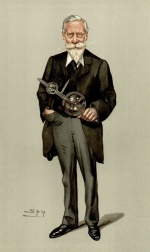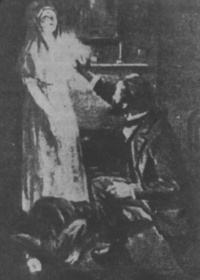William Crookes: Difference between revisions
Pablo Sender (talk | contribs) No edit summary |
Pablo Sender (talk | contribs) |
||
| Line 12: | Line 12: | ||
Prof. Crookes' younger brother Philip died prematurely in 1867 at age 21, which may have contributed to his interest in [[spiritualism]]. In 1870 Crookes stated that science had a duty to study the [[phenomena]] associated with spiritualism in an impartial way. | Prof. Crookes' younger brother Philip died prematurely in 1867 at age 21, which may have contributed to his interest in [[spiritualism]]. In 1870 Crookes stated that science had a duty to study the [[phenomena]] associated with spiritualism in an impartial way. | ||
He studied [[Mediumship|mediums]] such as Kate Fox, Florence Cook, and others, and witnessed many phenomena, including the appearance of ghostly characters, such as [[Katie King]]. His report on this research in 1874, concluded that these phenomena could not be explained as conjuring, and that further research would be useful. Most scientists were convinced that spiritualism was fraudulent, and Crookes' final report so outraged the scientific establishment "that there was talk of depriving him of his Fellowship of the Royal Society." Crookes then became much more cautious and didn't discuss his views publicly until 1898, when he felt his position was secure. From that time until his death in 1919, letters and interviews show that Crookes was a believer in spiritualism.<ref>See | He studied [[Mediumship|mediums]] such as Kate Fox, Florence Cook, and others, and witnessed many phenomena, including the appearance of ghostly characters, such as [[Katie King]]. His report on this research in 1874, concluded that these phenomena could not be explained as conjuring, and that further research would be useful. Most scientists were convinced that spiritualism was fraudulent, and Crookes' final report so outraged the scientific establishment "that there was talk of depriving him of his Fellowship of the Royal Society." Crookes then became much more cautious and didn't discuss his views publicly until 1898, when he felt his position was secure. From that time until his death in 1919, letters and interviews show that Crookes was a believer in spiritualism.<ref>See [http://en.wikipedia.org/wiki/William_Crookes#Spiritualism# William Crookes] in Wikipedia.</ref> | ||
== The Mahatmas on Prof. Crookes == | == The Mahatmas on Prof. Crookes == | ||
Revision as of 17:24, 21 November 2013
According to Readers Guide to The Mahatma Letters to A. P. Sinnett:
Crooks, Sir William, 1832-1919. English physicist and scientist of note; Member of the Royal Society. He achieved some remarkable results with experiments in "Radiant Matter." He was one of the "highest minds" whom the Adept Founders of the TS had hoped to interest in Theosophy. He became a member of the TS and One of the five councilors of the Society. HPB states (LBS, pp 224-5) that he was teaching a very occult doctrine and the the Mahatmas intended to help him. See ML index; SH index.[1]
Sir William Crookes and his wife joined The Theosophical Society in London on December 15, 1883, together with Charles Webster Leadbeater. In 1890 he was initiated into the Hermetic Order of the Golden Dawn, and in the 1890s joined the Society for Psychical Research. Later, he joined the Ghost Club, of which he was president from 1907 to 1912.
Spiritualism
Prof. Crookes' younger brother Philip died prematurely in 1867 at age 21, which may have contributed to his interest in spiritualism. In 1870 Crookes stated that science had a duty to study the phenomena associated with spiritualism in an impartial way.
He studied mediums such as Kate Fox, Florence Cook, and others, and witnessed many phenomena, including the appearance of ghostly characters, such as Katie King. His report on this research in 1874, concluded that these phenomena could not be explained as conjuring, and that further research would be useful. Most scientists were convinced that spiritualism was fraudulent, and Crookes' final report so outraged the scientific establishment "that there was talk of depriving him of his Fellowship of the Royal Society." Crookes then became much more cautious and didn't discuss his views publicly until 1898, when he felt his position was secure. From that time until his death in 1919, letters and interviews show that Crookes was a believer in spiritualism.[2]
The Mahatmas on Prof. Crookes
Master K.H. wrote:
So the great Mr. Crookes has placed one foot across the threshold for the sake of reading the Society's papers? Well and wisely done, and really brave of him. Heretofore he was bold enough to take a similar step and loyal enough to truth to disappoint his colleagues by making his facts public. When he was seeing his invaluable paper smothered in the "Sections" and the whole Royal Society trying to cough him down, metaphorically if not actually . . . he little thought how perfect a revenge Karma had in store for him. Let him know that its cornucopia is not yet emptied, and that Western Science has still three additional states of matter to discover. But he should not wait for us to condense ourselves up to the stethescopic standard as his Katy did; for we men are subject to laws of molecular affinity and polaric attraction which that sweet simulacrum was not hampered with. We have no favourites, break no rules. If Mr. Crookes would penetrate Arcana beyond the corridors the tools of modern science have already excavated, let him — Try. He tried and found the Radiometer; tried again, and found Radiant matter; may try again and find the "Kama-rupa" of matter — its fifth state. But to find it's Manas he would have to pledge himself stronger to secrecy than he seems inclined to. You know our motto, and that its practical application has erased the word "impossible" from the occultist's vocabulary. If he wearies not of trying, he may discover that that most noble of all facts, his true SELF. But he will have to penetrate many strata before he comes to It. And to begin with let him rid himself of the maya that any man living can set up "claims" upon Adepts. He may create irresistible attractions and compel their attention, but they will be spiritual, not mental or intellectual.[3]
See also
Notes
- ↑ George E. Linton and Virginia Hanson, eds., Readers Guide to The Mahatma Letters to A. P. Sinnett (Adyar, Chennai, India: Theosophical Publishing House, 1972), 219.
- ↑ See William Crookes in Wikipedia.
- ↑ Vicente Hao Chin, Jr., The Mahatma Letters to A.P. Sinnett in chronological sequence No. 111 (Quezon City: Theosophical Publishing House, 1993), 374.

